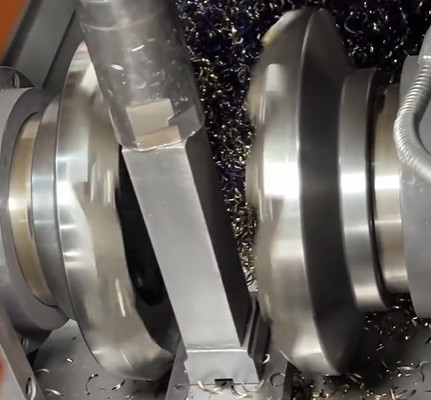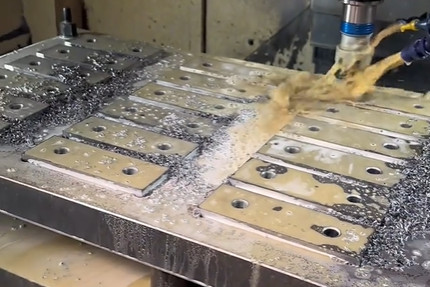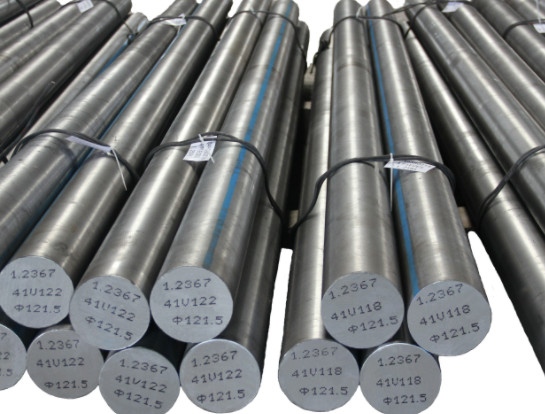Tool steel is a specialized group of carbon and alloy steels designed for manufacturing tools, dies, and molds due to its high hardness, wear resistance, and ability to retain shape under extreme conditions. Its composition, often enriched with elements like chromium, vanadium, molybdenum, and tungsten, enhances properties such as toughness, heat resistance, and abrasion resistance. These attributes make tool steel ideal for applications like cutting tools, punches, and dies, but they also pose significant machining challenges. Machining tool steel requires precise control of parameters, tool selection, and process optimization to achieve desired outcomes while minimizing tool wear and workpiece damage.
The machining process involves shaping tool steel through cutting, milling, turning, or grinding, typically using CNC machines for precision. The material’s high hardness (often 50-65 HRC after heat treatment) and tendency to work-harden demand specialized tools and techniques. This guide provides a detailed exploration of tool steel types, machining parameters, and associated difficulties, offering practical insights for machinists and engineers.
Types of Tool Steel and Their Machining Characteristics
Tool steels are categorized based on their alloying elements, heat treatment, and intended applications. Each type has unique properties that influence its machinability. Below is a summary of the primary tool steel types and their machining characteristics.
| Type | Key Properties | Common Applications | Machinability |
|---|---|---|---|
| High-Speed Steel (HSS) | High toughness, retains hardness at elevated temperatures | Drills, taps, milling cutters | Moderate; prone to work-hardening, requires sharp tools |
| Cold-Work Tool Steel (e.g., A2, D2) | High wear resistance, good dimensional stability | Blanking dies, punches, shear blades | Poor; high hardness increases tool wear |
| Hot-Work Tool Steel (e.g., H13) | Heat resistance, moderate toughness | Forging dies, extrusion tools | Moderate; requires controlled cutting speeds to avoid thermal damage |
| Shock-Resistant Tool Steel (e.g., S7) | High impact toughness, moderate hardness | Chisels, punches | Moderate; easier to machine in annealed state |
| Water-Hardening Tool Steel (e.g., W1) | High hardness, low cost | Hand tools, simple dies | Good in annealed state; poor after hardening |
High-Speed Steel (HSS), such as M2 and M42 grades, is commonly used for cutting tools due to its ability to maintain hardness at elevated temperatures. Its machinability is moderate, but it requires sharp tools to prevent chip adhesion and work-hardening. Cold-work tool steels like A2 and D2, with high carbon and chromium content, are highly wear-resistant but challenging to machine due to rapid tool wear. Hot-work tool steels, such as H13, are designed for high-temperature applications and require controlled cutting speeds to avoid thermal damage. Shock-resistant tool steels like S7 offer good toughness and are easier to machine in their annealed state. Water-hardening tool steels, such as W1, are cost-effective and machinable when annealed but become difficult after hardening.

Machining Parameters for Tool Steel
Effective machining of tool steel requires precise control of cutting parameters, including speed, feed rate, depth of cut, and tool material. These parameters vary depending on the tool steel type, its heat-treated condition, and the machining process. Below are recommended parameters for common machining processes.
| Process | Tool Steel Type | Cutting Speed (m/min) | Feed Rate (mm/rev) | Depth of Cut (mm) | Tool Material |
|---|---|---|---|---|---|
| Turning | HSS (M2) | 20-30 | 0.1-0.3 | 0.5-2.0 | Carbide, CBN |
| Milling | Cold-Work (D2) | 15-25 | 0.05-0.15 | 0.2-1.5 | Coated Carbide |
| Grinding | Hot-Work (H13) | 20-40 | 0.01-0.05 | 0.01-0.1 | Aluminum Oxide, CBN |
| Drilling | Shock-Resistant (S7) | 10-20 | 0.05-0.2 | 0.5-3.0 | Carbide, HSS-Co |
Turning: For turning tool steels, carbide or cubic boron nitride (CBN) tools are preferred due to their ability to withstand high hardness. Cutting speeds for HSS should be kept between 20-30 m/min to avoid excessive heat buildup, with feed rates of 0.1-0.3 mm/rev to ensure surface finish quality. Depth of cut should be limited to 0.5-2.0 mm to minimize tool stress.
Milling: Milling cold-work tool steels like D2 requires coated carbide tools to reduce wear. Cutting speeds of 15-25 m/min and feed rates of 0.05-0.15 mm/rev are recommended to balance material removal rate and tool life. Climb milling is preferred to reduce work-hardening.
Grinding: Grinding hot-work tool steels like H13 demands low feed rates (0.01-0.05 mm/rev) and shallow depths of cut (0.01-0.1 mm) to prevent surface burning. Aluminum oxide or CBN wheels are effective for achieving fine finishes.
Drilling: Drilling shock-resistant tool steels like S7 requires carbide or cobalt-alloyed HSS drills. Cutting speeds of 10-20 m/min and feed rates of 0.05-0.2 mm/rev help maintain drill life and prevent chip welding.
Coolant selection is critical. Water-based emulsions or synthetic coolants are effective for most tool steels, while dry machining may be suitable for annealed conditions to avoid thermal shock. Proper chip evacuation is essential to prevent recutting and tool damage.

Difficulties in Tool Steel Machining
Machining tool steel presents several difficulties due to its inherent properties. These challenges require careful planning and execution to overcome.
High Hardness and Tool Wear
Tool steels, especially after heat treatment, can reach hardness levels of 50-65 HRC, significantly increasing tool wear. Cold-work tool steels like D2, with high chromium content, are particularly abrasive, causing rapid wear on carbide tools. To mitigate this, use coated carbide or CBN tools and maintain conservative cutting parameters to extend tool life.
Work-Hardening Tendency
Many tool steels, particularly HSS and cold-work grades, exhibit work-hardening during machining. This increases surface hardness, making subsequent passes more difficult and increasing tool wear. To minimize work-hardening, use sharp tools, avoid excessive feed rates, and ensure continuous cutting to prevent dwell times.
Thermal Sensitivity
Hot-work tool steels like H13 are sensitive to thermal changes during machining. Excessive heat can lead to surface cracks or distortion, particularly in grinding operations. Controlled cutting speeds, effective coolant application, and low feed rates help manage heat generation.
Chip Formation and Evacuation
Tool steels often produce tough, stringy chips that can adhere to tools or clog machining areas, leading to poor surface finish or tool damage. Proper chip breakers on tools and high-pressure coolant systems improve chip evacuation, especially in drilling and milling operations.
Dimensional Accuracy and Surface Finish
Achieving tight tolerances and high-quality surface finishes is challenging due to tool steel’s hardness and tendency to deflect under cutting forces. Precision CNC machines with rigid setups and vibration-dampening techniques are essential. Finishing passes with low depths of cut and high spindle speeds improve surface quality.

Practical Recommendations for Effective Machining
To achieve successful tool steel machining, consider the following recommendations:
- Tool Selection: Use coated carbide, CBN, or ceramic tools for hard tool steels. Ensure tools are sharp and regularly inspected for wear.
- Machine Setup: Employ rigid CNC machines with high spindle accuracy to minimize vibration and deflection.
- Annealed State Machining: Whenever possible, machine tool steel in its annealed state to improve machinability, followed by heat treatment for final properties.
- Coolant Use: Apply appropriate coolants to reduce heat and improve chip evacuation. Avoid thermal shock by maintaining consistent coolant flow.
- Parameter Optimization: Adjust cutting speed, feed rate, and depth of cut based on the specific tool steel grade and condition. Refer to manufacturer data for precise guidelines.
- Tool Path Planning: Use optimized tool paths in CNC programming to minimize tool engagement time and reduce work-hardening risks.
Regular monitoring of tool wear and surface finish during machining helps identify issues early. Post-machining processes, such as stress relieving or polishing, may be necessary to achieve final dimensional accuracy and surface quality.
Conclusion
Machining tool steel requires a deep understanding of its types, properties, and associated difficulties. By selecting appropriate tools, optimizing machining parameters, and addressing challenges like high hardness, work-hardening, and thermal sensitivity, machinists can achieve high-quality results. The recommendations provided offer a practical framework for tackling tool steel machining, ensuring efficiency and precision in manufacturing processes.
